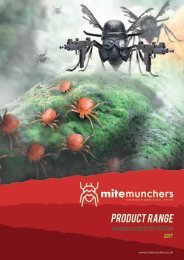MM Catalog 2017
Create successful ePaper yourself
Turn your PDF publications into a flip-book with our unique Google optimized e-Paper software.
9<br />
Garden chafer /COCK CHAFER<br />
Heterorhabditis SP<br />
Type: Insect parasitic nematodes.<br />
How it works: The spray application releases nematodes<br />
which seek out insect larvae / grubs in the soil<br />
entering them through natural openings. Once<br />
inside they release their symbiotic bacteria killing<br />
the grub. Nematodes multiply in the dead organism<br />
releasing a new generation.<br />
Species controlled: The Phyllopertha horticola<br />
present in turf. Other species of Chafer such as the<br />
Cockchafer Melolontha may not be adequately<br />
controlled owing to differences in life cycle.<br />
HETERORHABDITIS SP<br />
ENTOMOPATHENOGENIC NEMATODES<br />
N VERMICULITE 250,000,000 IN SEALED TRAYS<br />
£68.50<br />
When to use: In accordance with the Garden Chafer<br />
life cycle - when the larvae are close to the soil<br />
surface and when the soil surface is above 12°C.<br />
Typically treat from August to September. Later<br />
applications and the larvae may be too deep to be<br />
targeted and soil temperatures too low. Apply to<br />
wet ground (irrigate if required and afterwards).<br />
Nema-todes must pass through the thatch layer and<br />
into the soil and need to be kept moist for 2 - 3<br />
weeks. Nematodes are sensitive to sunlight so apply<br />
late in the day. Damage prevention will be noted the<br />
following spring when most damage is usually seen.<br />
Rates of use: 50 million pack treats 100 m2, 250<br />
million pack treats 500 m2











